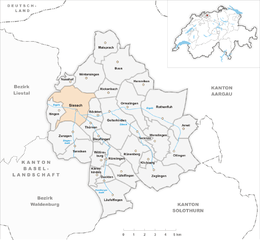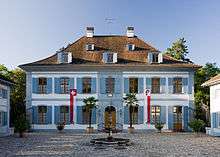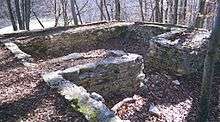Sissach
| Sissach | ||
|---|---|---|
 | ||
| ||
 Sissach | ||
|
Location of Sissach  | ||
| Coordinates: 47°28′N 7°49′E / 47.467°N 7.817°ECoordinates: 47°28′N 7°49′E / 47.467°N 7.817°E | ||
| Country | Switzerland | |
| Canton | Basel-Landschaft | |
| District | Sissach | |
| Area[1] | ||
| • Total | 8.87 km2 (3.42 sq mi) | |
| Elevation | 376 m (1,234 ft) | |
| Population (Mar 2016[2]) | ||
| • Total | 6,741 | |
| • Density | 760/km2 (2,000/sq mi) | |
| Postal code | 4450 | |
| SFOS number | 2861 | |
| Surrounded by | Böckten, Hersberg, Itingen, Lausen, Nusshof, Rickenbach, Thürnen, Wintersingen, Zunzgen | |
| Website |
www SFSO statistics | |
Sissach is a municipality and the capital of the district of Sissach in the canton of Basel-Country in Switzerland.
History
Sissach is first mentioned around 1225-26 as Sissaho.[3]
Geography

Sissach has an area, as of 2009, of 8.87 square kilometers (3.42 sq mi). Of this area, 2.5 km2 (0.97 sq mi) or 28.2% is used for agricultural purposes, while 4.13 km2 (1.59 sq mi) or 46.6% is forested. Of the rest of the land, 2.22 km2 (0.86 sq mi) or 25.0% is settled (buildings or roads), 0.02 km2 (4.9 acres) or 0.2% is either rivers or lakes and 0.01 km2 (2.5 acres) or 0.1% is unproductive land.[4]
Of the built up area, industrial buildings made up 2.8% of the total area while housing and buildings made up 12.4% and transportation infrastructure made up 6.3%. Power and water infrastructure as well as other special developed areas made up 1.6% of the area while parks, green belts and sports fields made up 1.9%. Out of the forested land, 45.1% of the total land area is heavily forested and 1.5% is covered with orchards or small clusters of trees. Of the agricultural land, 3.6% is used for growing crops and 16.9% is pastures, while 7.7% is used for orchards or vine crops. All the water in the municipality is flowing water.[4]
The municipality is the capital of the district with the same name. Sissach village was originally a linear village along the Ergolz river. By the beginning of the 21st Century, it had expanded to fill the entire valley and part of the slopes around the valley. It grew along the road between the Schafmatt and Unterer Hauenstein Jura passes. It includes the settlements of Itchon (first mentioned in 1226), and Gruonach and Wilmatten (both mentioned in 1446).
Coat of arms
The blazon of the municipal coat of arms is Per pale Gules and Argent, two Arms palewise counterchanged.[5]
Demographics



Sissach has a population (as of March 2016) of 6,741.[2] As of 2008, 17.0% of the population are resident foreign nationals.[6] Over the last 10 years (1997–2007) the population has changed at a rate of 16%.[7]
Most of the population (as of 2000) speaks German (4,723 or 88.7%), with Italian language being second most common (180 or 3.4%) and Portuguese being third (98 or 1.8%). There are 34 people who speak French and 5 people who speak Romansh.[8]
As of 2008, the gender distribution of the population was 49.5% male and 50.5% female. The population was made up of 5,113 Swiss citizens (82.7% of the population), and 1,069 non-Swiss residents (17.3%)[9] Of the population in the municipality 1,489 or about 28.0% were born in Sissach and lived there in 2000. There were 1,394 or 26.2% who were born in the same canton, while 1,351 or 25.4% were born somewhere else in Switzerland, and 938 or 17.6% were born outside of Switzerland.[8]
In 2008 there were 53 live births to Swiss citizens and 13 births to non-Swiss citizens, and in same time span there were 47 deaths of Swiss citizens and 2 non-Swiss citizen deaths. Ignoring immigration and emigration, the population of Swiss citizens increased by 6 while the foreign population increased by 11. There were 6 Swiss men and 8 Swiss women who emigrated from Switzerland. At the same time, there were 39 non-Swiss men and 31 non-Swiss women who immigrated from another country to Switzerland. The total Swiss population change in 2008 (from all sources, including moves across municipal borders) was an increase of 222 and the non-Swiss population increased by 65 people. This represents a population growth rate of 5.0%.[6]
The age distribution, as of 2010, in Sissach is; 444 children or 7.2% of the population are between 0 and 6 years old and 794 teenagers or 12.8% are between 7 and 19. Of the adult population, 935 people or 15.1% of the population are between 20 and 29 years old. 919 people or 14.9% are between 30 and 39, 946 people or 15.3% are between 40 and 49, and 1,194 people or 19.3% are between 50 and 64. The senior population distribution is 660 people or 10.7% of the population are between 65 and 79 years old and there are 290 people or 4.7% who are over 80.[9]
As of 2000, there were 2,185 people who were single and never married in the municipality. There were 2,549 married individuals, 330 widows or widowers and 261 individuals who are divorced.[8]
As of 2000, there were 2,332 private households in the municipality, and an average of 2.2 persons per household.[7] There were 829 households that consist of only one person and 116 households with five or more people. Out of a total of 2,378 households that answered this question, 34.9% were households made up of just one person and 10 were adults who lived with their parents. Of the rest of the households, there are 672 married couples without children, 660 married couples with children There were 119 single parents with a child or children. There were 42 households that were made up unrelated people and 46 households that were made some sort of institution or another collective housing.[8]
In 2000 there were 733 single-family homes (or 58.5% of the total) out of a total of 1,252 inhabited buildings. There were 240 multi-family buildings (19.2%), along with 177 multi-purpose buildings that were mostly used for housing (14.1%) and 102 other use buildings (commercial or industrial) that also had some housing (8.1%). Of the single-family homes 66 were built before 1919, while 111 were built between 1990 and 2000. The greatest number of single-family homes (155) were built between 1946 and 1960.[10]
In 2000 there were 2,452 apartments in the municipality. The most common apartment size was 4 rooms of which there were 687. There were 100 single room apartments and 753 apartments with five or more rooms. Of these apartments, a total of 2,278 apartments (92.9% of the total) were permanently occupied, while 111 apartments (4.5%) were seasonally occupied and 63 apartments (2.6%) were empty.[10] As of 2009, the construction rate of new housing units was 4.4 new units per 1000 residents.[7] As of 2000 the average price to rent a two-room apartment was about 836.00 CHF (US$670, £380, €540), a three-room apartment was about 1069.00 CHF (US$860, £480, €680) and a four-room apartment cost an average of 1282.00 CHF (US$1030, £580, €820).[11] The vacancy rate for the municipality, in 2010, was 0.55%.[7]
The historical population is given in the following chart:[3][12]

Heritage sites of national significance
Bischofstein Castle and Sissacherfluh Castle (both prehistoric hilltop settlement and medieval castle), Ebenrain Castle, the prehistoric hilltop settlement of Burgenrain and the reformed parish Church of St Jakob are listed as Swiss heritage site of national significance. The entire town of Sissach is part of the Inventory of Swiss Heritage Sites.[13]
 Bishofstein Castle
Bishofstein Castle Ebenrain Castle
Ebenrain Castle Reformed parish Church of St Jakob
Reformed parish Church of St Jakob Sissacherfluh Castle
Sissacherfluh Castle
Politics
In the 2007 federal election the most popular party was the SVP which received 26.89% of the vote. The next three most popular parties were the Green Party (24.28%), the SP (22.43%) and the FDP (18.11%). In the federal election, a total of 2,077 votes were cast, and the voter turnout was 51.8%.[14]
Economy
As of 2010, Sissach had an unemployment rate of 2.8%. As of 2008, there were 117 people employed in the primary economic sector and about 23 businesses involved in this sector. 1,510 people were employed in the secondary sector and there were 76 businesses in this sector. 2,066 people were employed in the tertiary sector, with 310 businesses in this sector.[7] There were 2,902 residents of the municipality who were employed in some capacity, of which females made up 43.3% of the workforce.
In 2008 the total number of full-time equivalent jobs was 3,117. The number of jobs in the primary sector was 60, of which 52 were in agriculture and 7 were in forestry or lumber production. The number of jobs in the secondary sector was 1,431, of which 898 or (62.8%) were in manufacturing, 2 or (0.1%) were in mining and 516 (36.1%) were in construction. The number of jobs in the tertiary sector was 1,626. In the tertiary sector; 526 or 32.3% were in wholesale or retail sales or the repair of motor vehicles, 53 or 3.3% were in the movement and storage of goods, 110 or 6.8% were in a hotel or restaurant, 45 or 2.8% were in the information industry, 68 or 4.2% were the insurance or financial industry, 146 or 9.0% were technical professionals or scientists, 210 or 12.9% were in education and 191 or 11.7% were in health care.[15]
In 2000, there were 2,666 workers who commuted into the municipality and 1,887 workers who commuted away. The municipality is a net importer of workers, with about 1.4 workers entering the municipality for every one leaving. About 5.0% of the workforce coming into Sissach are coming from outside Switzerland.[16] Of the working population, 28.8% used public transportation to get to work, and 42.1% used a private car.[7]
Religion
From the 2000 census, 1,270 or 23.8% were Roman Catholic, while 2,927 or 55.0% belonged to the Swiss Reformed Church. Of the rest of the population, there were 23 members of an Orthodox church (or about 0.43% of the population), there were 13 individuals (or about 0.24% of the population) who belonged to the Christian Catholic Church, and there were 138 individuals (or about 2.59% of the population) who belonged to another Christian church. There were 5 individuals (or about 0.09% of the population) who were Jewish, and 227 (or about 4.26% of the population) who were Islamic. There were 10 individuals who were Buddhist, 19 individuals who were Hindu and 4 individuals who belonged to another church. 542 (or about 10.18% of the population) belonged to no church, are agnostic or atheist, and 147 individuals (or about 2.76% of the population) did not answer the question.[8]
Weather
Sissach has an average of 137.8 days of rain or snow per year and on average receives 1,027 mm (40.4 in) of precipitation. The wettest month is August during which time Sissach receives an average of 122 mm (4.8 in) of rain or snow. During this month there is precipitation for an average of 12.7 days. The month with the most days of precipitation is May, with an average of 13.5, but with only 108 mm (4.3 in) of rain or snow. The driest month of the year is February with an average of 65 mm (2.6 in) of precipitation over 11.2 days.[17]
Education
In Sissach about 2,156 or (40.5%) of the population have completed non-mandatory upper secondary education, and 762 or (14.3%) have completed additional higher education (either university or a Fachhochschule). Of the 762 who completed tertiary schooling, 68.9% were Swiss men, 20.1% were Swiss women, 7.1% were non-Swiss men and 3.9% were non-Swiss women.[8]
As of 2000, there were 572 students in Sissach who came from another municipality, while 177 residents attended schools outside the municipality.[16]
Notable Residents
- 1975 DJ Antoine (real name Antoine Konrad), Swiss DJ producer based in Basel
References
- ↑ Arealstatistik Standard - Gemeindedaten nach 4 Hauptbereichen
- 1 2 Canton of Basel-Land Statistics, Wohnbevölkerung nach Nationalität und Konfession per 31. März 2016 (German) accessed 30 August 201
- 1 2 Sissach in German, French and Italian in the online Historical Dictionary of Switzerland.
- 1 2 Swiss Federal Statistical Office-Land Use Statistics 2009 data (German) accessed 25 March 2010
- ↑ Flags of the World.com accessed 08-March-2011
- 1 2 Swiss Federal Statistical Office - Superweb database - Gemeinde Statistics 1981-2008 (German) accessed 19 June 2010
- 1 2 3 4 5 6 Swiss Federal Statistical Office accessed 08-March-2011
- 1 2 3 4 5 6 STAT-TAB Datenwürfel für Thema 40.3 - 2000 (German) accessed 2 February 2011
- 1 2 Canton of Basel-Land Statistics, Wohnbevölkerung nach Nationalität und Konfession per 30. September 2010 (German) accessed 16 February 2011
- 1 2 Federal Statistical Office STAT-TAB - Datenwürfel für Thema 09.2 - Gebäude und Wohnungen (German) accessed 28 January 2011
- ↑ Canton of Basel-Land Statistics, Mieter- und Genossenschafterwohnungen1 nach Zimmerzahl und Mietpreis 2000 (German) accessed 20 February 2011
- ↑ Swiss Federal Statistical Office STAT-TAB Bevölkerungsentwicklung nach Region, 1850-2000 (German) accessed 29 January 2011
- ↑ "Kantonsliste A-Objekte:Basel-Landschaft" (PDF). KGS Inventar (in German). Federal Office of Civil Protection. 2009. Retrieved 12 July 2010.
- ↑ Swiss Federal Statistical Office, Nationalratswahlen 2007: Stärke der Parteien und Wahlbeteiligung, nach Gemeinden/Bezirk/Canton (German) accessed 28 May 2010
- ↑ Swiss Federal Statistical Office STAT-TAB Betriebszählung: Arbeitsstätten nach Gemeinde und NOGA 2008 (Abschnitte), Sektoren 1-3 (German) accessed 28 January 2011
- 1 2 Swiss Federal Statistical Office - Statweb (German) accessed 24 June 2010
- ↑ "Temperature and Precipitation Average Values-Table, 1961-1990" (in German, French, and Italian). Federal Office of Meteorology and Climatology - MeteoSwiss. Retrieved 8 May 2009., the Sissach weather station elevation is 380 meters above sea level.
External links
| Wikimedia Commons has media related to Sissach. |
- Official website (German)
